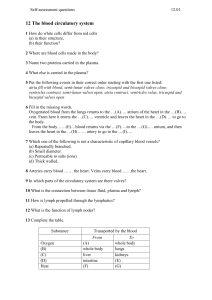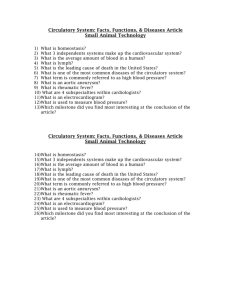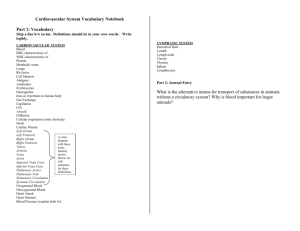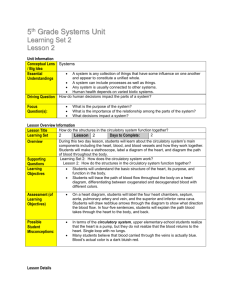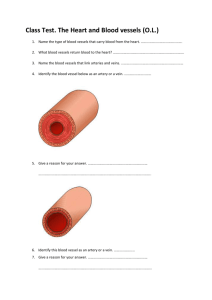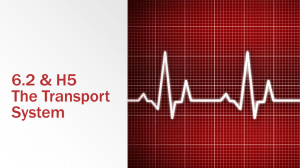File
advertisement
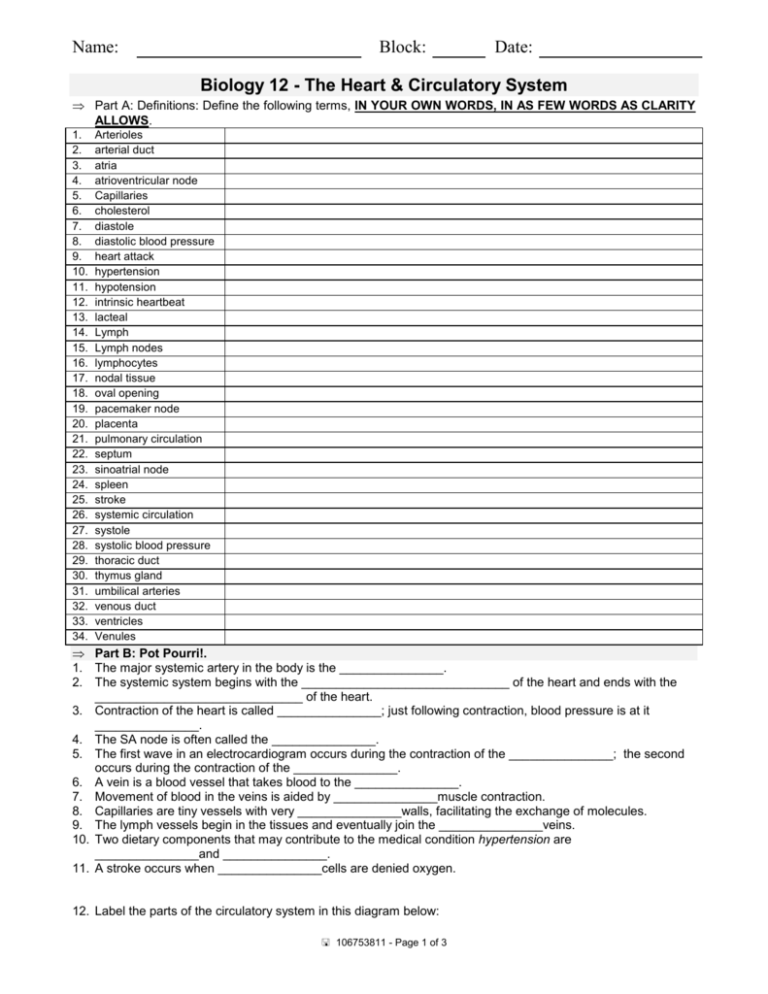
Name: Block: Date: Biology 12 - The Heart & Circulatory System Part A: Definitions: Define the following terms, IN YOUR OWN WORDS, IN AS FEW WORDS AS CLARITY ALLOWS. 1. 2. 3. 4. 5. 6. 7. 8. 9. 10. 11. 12. 13. 14. 15. 16. 17. 18. 19. 20. 21. 22. 23. 24. 25. 26. 27. 28. 29. 30. 31. 32. 33. 34. Arterioles arterial duct atria atrioventricular node Capillaries cholesterol diastole diastolic blood pressure heart attack hypertension hypotension intrinsic heartbeat lacteal Lymph Lymph nodes lymphocytes nodal tissue oval opening pacemaker node placenta pulmonary circulation septum sinoatrial node spleen stroke systemic circulation systole systolic blood pressure thoracic duct thymus gland umbilical arteries venous duct ventricles Venules Part B: Pot Pourri!. 1. The major systemic artery in the body is the _______________. 2. The systemic system begins with the ______________________________ of the heart and ends with the ______________________________ of the heart. 3. Contraction of the heart is called _______________; just following contraction, blood pressure is at it _______________. 4. The SA node is often called the _______________. 5. The first wave in an electrocardiogram occurs during the contraction of the _______________; the second occurs during the contraction of the _______________. 6. A vein is a blood vessel that takes blood to the _______________. 7. Movement of blood in the veins is aided by _______________muscle contraction. 8. Capillaries are tiny vessels with very _______________walls, facilitating the exchange of molecules. 9. The lymph vessels begin in the tissues and eventually join the _______________veins. 10. Two dietary components that may contribute to the medical condition hypertension are _______________and _______________. 11. A stroke occurs when _______________cells are denied oxygen. 12. Label the parts of the circulatory system in this diagram below: 106753811 - Page 1 of 3 1. 2. 4. 5. 7. 8. 10. 11. 13. 14. 16. 13. Match the structures in the key to the statements below: Key: ARTERY VEIN CAPILLARY i. has the thickest walls: _______________ ii. has valves: _______________ iii. has the greatest total cross-sectional area: _______________ iv. takes blood away from the heart: _______________ v. takes blood to the heart: _______________ vi. exchanges carbon dioxide and oxygen with tissues: _______________ 14. The path of blood through the heart. Starting with vena cava, list the structures in order through which blood flows. Use the parts in the column on the left. Structures (Alphabetical listing) Correct Order 1. aorta 2. bicuspid valve 3. left atrium 4. left ventricle 5. lungs 6. pulmonary artery 7. pulmonary semilunar valve 8. pulmonary veins 9. right atrium 10. right ventricle 11. semilunar valve 12. tricuspid valve 13. vena cava 3. 6. 9. 12. 15. 9 1 10 2 11 3 12 4 13 5 14 15 6 7 16 8 15. The heart beats about _______times a minute. What actually happens is that the _______________node initiates the contraction of the _______________(chambers). The nervous stimulus is picked up by the ______________________________node, and this initiates the contraction of the _______________(chambers). When the chambers are not actually contracting, they are relaxing. Contraction is termed systole, and resting is termed _______________. 16. When the atria contracts, this forces the blood through the ______________________________valves into the ______________________________. The closing of these valves is the lub sound. Next the ventricles contract and force the blood into the arteries. Now the ______________________________valves close, and this is the DUPP sound. A heart murmur is caused by ______________________________. 17. Using the diagram of the circulatory system in your text that shows the major blood vessels, trace the path of blood from: i. the left ventricle to the legs: _______________, _______________, _______________, _______________ ii. the legs to the right atrium: _______________, _______________, _______________ iii. the aorta to the liver: _______________, ______________________________, _______________, ______________________________, _______________ iv. the liver to the vena cava: _______________, ______________________________, _______________ 106753811 - Page 2 of 3 Name: Block: Date: 18. a) Label the indicated parts of the fetal heart at righ: b. List the four structural differences between the fetal circulatory system and the adult, as well as the function of each difference. Structure A Function Structure B Function Structure C Function Structure D Function ___________ ____________ 19. There are only two types of lymph vessels, the lymph ______________________________and the lymph _______________. 20. Mix and match the correct term for each description on the left. ___ 1. largest artery A valves ___ 2. returns tissue fluid to the circulatory system B thrombus ___ 3. prevent blood from flowing in the wrong direction C systolic blood pressure ___ 4. vessel transporting blood through kidneys D stroke ___ 5. vessel transporting blood through legs E renal ___ 6. localized swelling due to excess tissue fluid F lymphatic system ___ 7. supply blood to the heart G iliac ___ 8. the highest arterial pressure H hypertension ___ 9. the lowest arterial pressure I heart attack ___ 10. condition of high blood pressure J embolism ___ 11. "hardening of the arteries" K edema ___ 12. a stationary clot along an arterial wall L diastolic blood pressure ___ 13. a dislodged, moving thrombus M coronary arteries ___ 14. when a portion of the brain dies due to a lack of oxygen N atherosclerosis ___ 15. chest pain (including pain in the left arm) O aorta ___ 16. occurs when circulation to part of the heart is blocked P angina pectoris 21. How is a lymph capillary like a blood capillary? a) they both contain blood b) they both contain valves c) they both have thin walls d) they are both connected to the vena cava 22. If you press a finger down on a prominent vein, say, on the back of your hand and then slide the finger distally to a new pressure point closer to the fingers, would you expect the section of vein you just moved along to refill with blood? Suppose you had moved the finger proximally toward the upper arm? 23. Explain how the blood that right now is arriving at your fingertips will get back to your heart. What will drive its movement? 106753811 - Page 3 of 3
